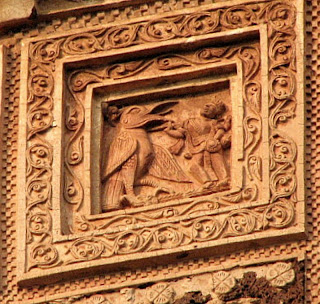
I came across ‘Abduction’ of Paul Cézanne and ‘Killing of Jatayu’ by Ravi Varma almost at the same time. Then I thought of writing a few lines on these paintings and the situations of abduction as portrayed by these artistes, centuries and miles apart.
The word ‘Abduction’ means ‘carry off a person illegally by force or deception’ (Source : Concise Oxford Dictionary) or kidnapping in short. The parent is the Latin word : Abducere. Stories of abduction, of beauties and vulnerable , are aplenty in our mythology and history. Epics have been written around tales of abduction and stirred artistes to create canvasses depicting the acts and dark emotion of abduction.

Cézanne’s painted ‘The Abduction’ in oil on a 35”X45” canvas ( Fitzwilliam Museum, Cambridge, UK ) . It shows the raw passion and the force of the man who is carrying away a woman in the nude. The dark background of the canvas emphasises the dark mood of the act. The contrast of skins’ colours of the two key figures in this canvas is the contrast between the sexual desire of one and the fear of the same in the other. In my computer screen , I could not decipher what the far-off characters are doing…… are they intoxicated and therefore made no attempt to rescue the abducted woman or they are thrown on the ground by the brute force of the abductor. He painted this canvas in 1867 AD when he was 38 years old.

Ravi Varma painted Seeta's abduction scene from Ramayana The mood of the painting of Ravana fighting with Jatayu with a sword in his right hand , while he holds on to Seeta with his left is different from that of Cezane. Ravana abducted Seeta primarily to avenge his sister Shurpanakha’s humiliation in the hands of Rama and Lakshmana. Ravana’s high libido played a part in the act too. Ravana’s posture exudes power …. he overpowers Jatayu and holds onto Seeta with his left hand. Ravana’s posture and face depict heightened flow of adrenaline . Ravi Varma has not left any hint of sexual energy here.
Before I sign off, I would have liked to add a photo of this abduction scene on terra cotta panel. But, I have none in my HDD .I shall look for the same in future trips to locations of terra cotta temples . Here , we have photos of Seeta being deceived by Ravana in guise of a sage , Ravana fighting with Jatayu ( his wings are not chopped yet ) and fillnally abducted Seeta under a tree from where Hanuman is watching her.


 These panels tell the 'story' , but drawn in static style, expresses no emotion.
These panels tell the 'story' , but drawn in static style, expresses no emotion.

